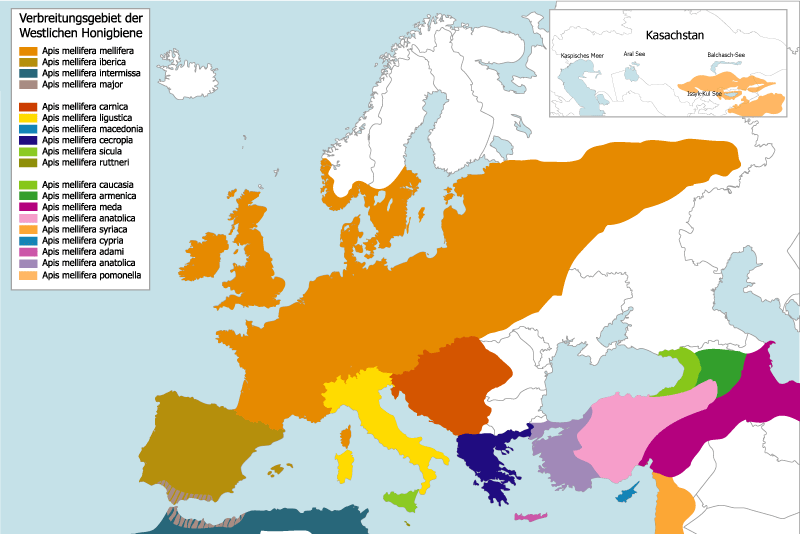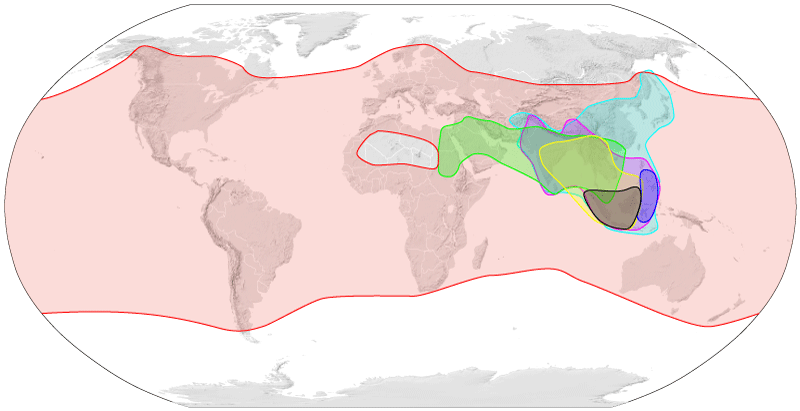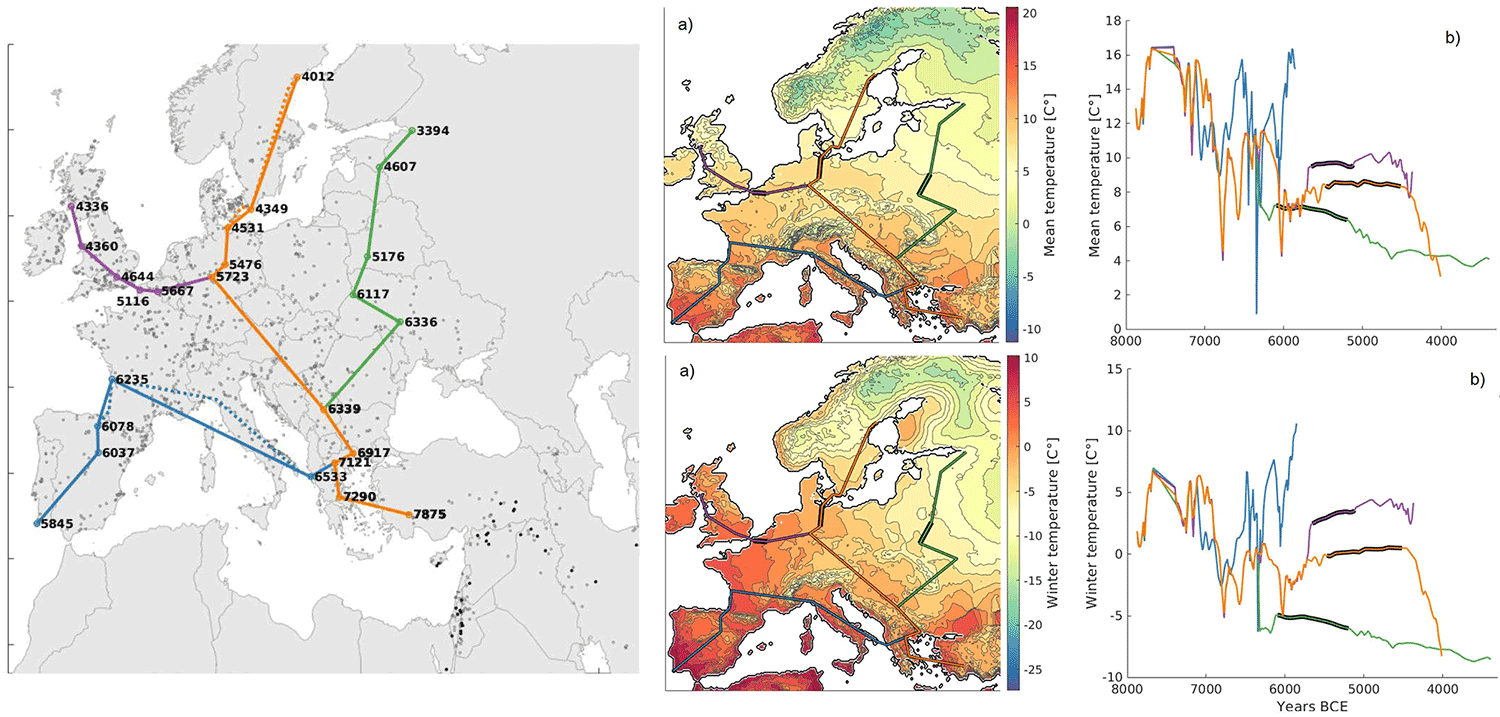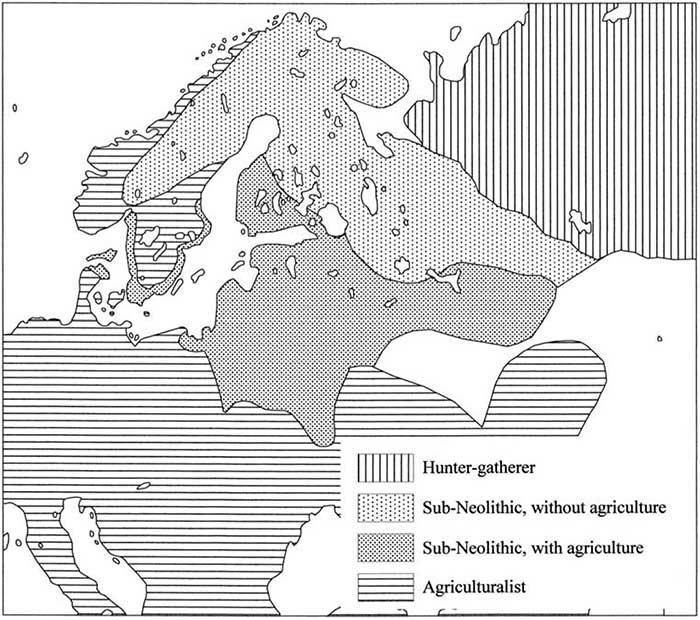This post is part of a draft on palaeolinguistics and the Proto-Uralic homeland. See below for the color code of protoforms.
5. Apiculture
5.1. Honey and honeybees
PU (Saa. ← Fi., Md., Ma.?, Hu., P → Smy.) *meti ‘honey, nectar’ (UEW Nº 539) ← PIE/Pre-PIIr. *medʰu ‘honey, mead’.
NOTE. The specific source PIE stage is impossible to determine with precision. For supporters of Indo-Uralic, the dental could represent the divergent evolution in both dialects (Kümmel 2019). However, the substitution of PIE *dʰ for PU *t and final PIE *-u for PU *-i are regular changes in Late PIE/Pre-PIIr. borrowings, and this is thus its most straightforward origin (Holopainen 2019: 146-147 with references). As for a relationship with Proto-Semitic *mataḳ- ‘sweet’, see Bjørn (2017: 95).
PFU (Fi., Md., Ma., P., Hu.) *mekši ‘honeybee’ (UEW Nº 534). Schrader (1923—29; 139, 314), Jacobsohn (1922: 161), Moór (1956), KEWA, Schindler (1972: 36), or Burrow (1973: 25) considered the isolated Indo-Iranian forms a PU borrowing into PIIr. *makš-i (cf. O.Ind. mákṣā- ‘bee’, makṣikā- ‘fly; bee’; Av. maχśī- ‘fly’). The presence of an *š suggests it is an Agricultural Substrate word, but with a widespread distribution in Uralic.
NOTE. The Uralic forms could have been an early loanword from a Pre-PIIr. **mekš-, although the stem vowel in *-i and the attribution of the ruKi-rule to an early stage (based on other early loans) are problematic. The PIIr. stem has also been compared unconvincingly – as “a by-form without a palatal” (Mallory & Adams 2006) – to a hypothetic root **mekʲ- (Derksen 2015) behind O.Ind. maśáka- ‘mosquito, horsefly, gnat’ and Baltic *mašalas. For an extended discussion, see Holopainen (2019: 139-142 with references).

PFP (Md., Ma., P) *śišta ‘beeswax’ (UEW Nº 1615) ~ PIIr. *ćišta-, attested in O.Ind. madʰu-śiṣta- ‘beeswax’, from śiṣta- ‘rest’ without a cognate in Iranian or any other Indo-European language (Holopainen 2019: 249 with references). Based on the existence of root verb Skt. śeṣ- ‘to leave behind’, it seems attractive to posit an Indo-Iranian origin. Most relevant for the direction of borrowing is the potential reconstruction of Pre-PMd. *šikšta (Keresztes 1986: 161-162) which would relate both ultimately to an Agricultural Substrate language.
NOTE. According to Kallio (p.c. referred to in Holopainen 2019), Md.E kšta probably resulted from epenthesis. This argument of an epenthetic k is based on the parallel found in Mordvin E kšna, M šna ‘belt’ ← PMd. *šišna, cognate with Baltic *šikšna (cf. Lith. šikšnà ‘id.’, Latv. siksna ‘id’); cf. also Fi hihna (Keresztes 1986: 68–69). Fi., Md., and Ma. show irregular sound correspondences, but Grünthal’s (2012: 318) suggestion of an ultimate origin in parallel Baltic borrowings is impossible to verify, based on the lack of Indo-European cognates (ALEW 2020). Furthermore, a similar variation in substratal words is found e.g. in PU (Fi, Md.) *šukšto-/*šukšta- ‘rinse, wash’ (v.i.), which supports – combined with the cluster *kš – the common origin in the Agricultural Substrate, hence also most likely borrowed from one Uralic dialect into Baltic, contra Junttila (2015: 29).
PFP (Fi., Md.?, Ma.?, P?) *karas ‘honeycomb’ has been hypothesized to be a loan from an unattested PIIr. **kāras. Holopainen (2019: 146) considers more likely multiple independent loans, possibly stemming ultimately from a Balt(o-Slav)ic source; cf. O. Lith. kõris, korỹs, Ltv. kâre(s) ‘honeycomb’. Possibly here also Gk. kēríon ‘honeycomb’, kērós (Dorian kārós), ‘wax’ (Lat. cēra ‘wax’, possibly a loan from Attic-Ionic?), maybe even Toch. B śeriye ‘wax, honeycomb?’ (Adams 1999: 633). Also proposed is an older PIE r/n-stem underlying PGmc. *hunangą ← Pre-PGmc. *kn̥h₂-on-kó- (Mallory & Adams 1997), a root also found in Gk. knēkos, possibly meaning ‘brownish yellow, amber’ (Kroonen 2013). Again, the lack of a proper IE etymology renders the ultimate origin of the whole set (hence direction of borrowing) uncertain.
Holopainen’s (2019, passim) circular reasoning that apiculture words are probably Pre-PIIr. – despite being potentially older substratal loans – based on the likely (Pre-)PIIr. origin of the other related words puts the assumption for them all on shaky ground; especially because NWIE and Palaeo-Balkan IE languages seem to continue an inherited honey-related vocabulary, whereas Indo-Iranian shows a trend to replace it. Furthermore, terms like *melit- ‘honey’ – from which the word for ‘bee’ is derived in Palaeo-Balkan languages – and *bʰei- ‘bee’ (common in NWIE, but also behind PIr. *báinā, *bainačī́) are the only ones clearly reconstructible for the parent language, which likely reflects a “border Neolithic” situation of Late Proto-Indo-European similar to Proto-Uralic.
What is certain is that PU and some IE dialects shared a common, ancient vocabulary related to honey hunting and/or honey harvesting, which all Uralic dialects (except Saami and Samoyedic, for obvious reasons) have kept until today. Compare here also PU? (Ma.? Ms., Kh. → Smy) *mäkV ‘honey’ (UEW Nº 526). This suggests that the populations that retained those words have continuously inhabited territories where this activity was relevant for their subsistence economy.
5.2. Honey harvesting
Due to the scarcity of research, especially of ancient samples in population genomics, it is very difficult to know where honeybee domestication was present at any given time in prehistory. It is very likely that Mesolithic groups from (Western) Europe practised honey hunting regularly (Dams 2015), and it is known that Neolithic groups show widespread exploitation of bee products, in some cases intensively and continuously, since around 7000 BC (Roffet-Salque et al. 2015).
The best approximation to a prehistorical northern limit to beekeeping appears in the same paper: 57 degrees latitude, based on the examination of hundreds of vessels from Scotland, Norway, Sweden and Finland without a trace of beeswax, suggesting that the climate there was too cold for bees, a limit quite similar to that of potential beekeeping today:

6. Agriculture
6.1. Grain
PFU (P, Ms.) *puśnV/*pućVnV ‘flour’ (UEW Nº 825; Häkkinen 2009: 29-30; Zhivlov 2015).
NOTE. The editors of the UEW note that this word “probably denoted originally flour prepared from a wild grain.” Without further explanation as to why they believed that, it is difficult to see how this is “probably” the case.
PFU (P, Kh., Ms.) *rekkV ‘mush, porridge’ (UEW Nº 855).
NOTE. Häkkinen (2001: 175) considers that “porridge-like foodstuffs can be prepared from non-grain foodstuffs.” It should also be added that porridge was probably known to Mesolithic hunter-gatherers, and could be prepared from wild grains. On the other hand, porridge was most certainly a staple food for prehistoric societies that practised some form of agriculture, and the existence of a specific PU word for that meal, as well as its survival to this day, seems like a relevant hint for their diet and subsistence economy.
PFP (Fi., Md., Ma.) *wešnä ‘spelt(Md.-Ma.)/wheat(Fi.)’ (UEW Nº 1707), very likely borrowed from the Agricultural Substrate (UEW Nº 1707; Häkkinen 2009: 38; Aikio 2015: 45; Zhivlov 2015; Holopainen 2019: 264-265 with references). PP *oć derives from a different source, PIr. *ac- ‘sharp’.
NOTE. The protoform is reminiscent of PIt. *aweksnā- (De Vaan 2008: 64-65) ← **h₂eweks-neh₂? ‘oats’. Compare PBSl. *awiź-/*awiś- ← Pre-PBSl. **h₂ewigʲʰ(s)-eh₂? ‘oats’ (Schrijver 1991: 47). A different suffix underlies Baltic and Slavic forms, though (Derksen 2008: 384-385). Both alternating forms point to a non-IE substrate borrowing in NWIE. Semantically there seems to be no problem in accepting its connection with the PU reconstruct, so a protoform in common with both (PU and NWIE) agricultural substrates would reflect something like **hₐweKš-na?, in line with the typical cluster *kšn described for the PU substratum (Aikio 2015). Of course, this is a speculative Proto-Indo-European-like reconstruction for a non-IE substratal word whose attestation is irregular by definition; furthermore, it features laryngeals at a late NWIE stage when vowel colouring and laryngeal loss had probably already happened in most contexts.
PFP (Md., Ma., P) *čaši/*šaši ‘barley / malt’ (UEW Nº 1222; Aikio 2015:45).
PFP (Ma., P, Kh. → Ms., Hu.?) *šeŋti? ‘grain’ (UEW Nº 998), from PMa. *šĕδäŋ, PP *šogdi, PKh. *sentä (Häkkinen 2009: 29).
NOTE. Aikio (2015 LU: 12), on the other hand, considers the Mari and Komi forms irregular, suggesting a non-Uralic origin, but analyzes Pre-PKh. (and possibly Hu.?) as from **sew-ntä, from PU *sewi- ‘eat’ and deverbal suffix *-ntä. Häkkinen (2001: 175-176) considered the word’s evolution “problematic both etymologically and phonologically”, and added that it “is not recorded at all in the languages from the western end of the family”. However, since western languages received multiple loan layers related to farming in general and grain in particular, it is unclear what the problem would be in assuming replacement.
PFP (Saa. ← Fi., Md., P ?→ Smy.) *jewä ‘grain’ (UEW Nº 1245) ← PIE/Pre-PIIr. *jewo- ‘cereal, grain; barley, spelt; cattle fodder’, cf. Skt. jáva- ‘grain, corn, barley’, Gk. ζειᾱ́ ‘einkorn wheat, used as fodder for horses; spelt’.
NOTE. Alternatively, the different stems might reflect quite early but parallel borrowings in the different branches (Holopainen 2019: 103-105 with references):
- A possible (areal) explanation for Pre-PFi. *jewä ← (Pre-)PBSl *jewo-, cf. PBal. *javas ‘corn, grain’ (Derksen 2015: 210). On the other hand, for Finnic indirect areal contacts with Indo-Iranian, cf. PFi. *očra ‘barley’ from either PIIr. *acra- ‘sharp’ (also likely behind PP *oć ‘spelt’), or less attractive Baltic cognate *aštra-.
- PMd. *juv ‘cereal’ ←? PIIr. *jawi/jowa.
- PP *ju ‘grain’ ←? PIr. *jawa.
- PSmy. *jäə̑ ‘flour’ ← ?Pre-PSmy. *jäwi (‘flour’) likely from Permic or Iranian.
PFP (Fi., Md., Ma.) *śora ‘grain’ (UEW Nº 1596) ← PBSl. *śara- ‘grain’, cf. Lith šãras (Holopainen, Junttila & Kuokkala 2017).
Pre-PFi *šatas ‘seed’ ← PIr. *dza-ta- ← PIIr. *ʒ́an- ‘be born, grow’ (Holopainen 2019: 257-258 with references).
NOTE. The alternative solution offered by LÄGLOS and repeated in Holopainen (2019: 258 with references) from a PGmc. ˣsāda- must be rejected, since the proper form is PGmc. *sēda- or *sēdi- (Kroonen 2013: 429-430), unless a later loan is proposed, which seems incompatible with Pre-PFi. chronology. Cf. here also from the same late layer of Proto-Iranian borrowings Pre-PFi. *sen-tü- ‘be born’ ← Pre-PIr. *dzen- ‘be born’; and PWU/Pre-Md *serä ‘old, aged’ Pre-PIr. *dzer-o- ‘old’.

6.2. By-product
PU *täštä ‘star, mark’ (UEW Nº 1635), cf. PSaa. *tāsnē, Pre-PFi. *täšte-, *täštäs ‘star’, *täšn- ‘spot’, PMd. *täštV ‘spelt’, PMa. *tištǝ ‘cut, notch, sign’. Weird phonological and semantic correspondence, possibly goes back to the Agricultural Substrate language, based on Mordvin (Aikio 2015: 43-44) and on some of the reconstructed meanings. It might have replaced PU (P, Kh., Ms., Hu., Smy.) *kuńći ‘star’ (UEW Nº 409; Zhivlov 2015).
PWU (Fi., Md.) *olki/*ulki ‘straw’ (UEW Nº 1450), suspected by Aikio (2015:46) to belong to a Finno-Permic Agricultural Substrate based on its “distribution, meaning and phonological irregularity”(?).
PFP (Fi.? Md. Ma. P) *teškä/*tekšä ‘something protruding: top, beard, head of corn, plant, shrub’ (UEW Nº 1642). Based on the reconstruction of an *š, possibly an Agricultural Substrate word.
PU (Saa.?, Fi., Md., Smy.) *pakša ‘knot, gnarl, bulb’ (UEW Nº 694). Based on the reconstruction of an *š, possibly an Agricultural Substrate word, but with a widespread distribution in Uralic.
PFP (Md., Ma., P) *ćuka ‘awn’ (UEW Nº 1599) ← PIIr. *ćūkā- (cf. O.Ind. śūkā́ ‘awn; bristle’, Av sūkā- ‘spike, needle’), or *cūčī- (cf. O.Ind. suci-), a possible BMAC substrate word (Lubotsky 2001:313).
NOTE. PWU (Saa., Fi.) *śukā ‘comb’ (UEW Nº 1599) ← PBSl. *śukā ‘comb, woolcomb’. It cannot be from a later (Proto-)Baltic because the initial consonant would have yielded Finno-Samic *š → PSaa. *s, PFi. *h (Holopainen 2019: 254-255 with references; Aikio 2020: 139-141 with references).
6.3. Stock & Grind
PFP (Fi., Md., Ma.) *jaŋša-/*jaša- ‘to grind’ (UEW Nº 1240; Aikio 2015:45). It might have replaced PU (P, Ms.) *puśnV/*pućVnV ‘flour’ (Zhivlov 2015).
PFP (Fi., Md., Ma.) *šumar/*šuwar ‘mortar’ (UEW Nº 1624; Aikio 2015:45; Zhivlov 2015).
PWU (Fi., Md.) *šukšto-/*šukšta- ‘to rinse / to wash’ (UEW Nº 1622; Aikio 2015:45).
PFP (Fi, P) *riŋiši/*ruŋiši/*rüŋiši ‘drying barn’ (UEW Nº 1525; Aikio 2015:45).
6.4. Land
P(W)U (Saa., Fi., Md., Smy.?) *muδ́a ‘earth, land’. Borrowed into Pre-PGmc. *muþþa- from “the predecessor of Samic and Finnic”, with the same semantic innovation ‘earth’ → ‘soil’ → ‘mud’. According to Aikio (2002: 23), the presence of regular counterparts in Samoyedic and the lack of good Indo-European etymology points to this direction of borrowing.
PFP (Saa.? Fi., Md.? Ma. P) *lamta/*le̮nti ‘low, lowland (← pasture?)’ (UEW Nº 455) ←? NWIE *londʰom as proposed by Kovulehto (2001) seems – depending on the PU protoform – phonologically less attractive than PBSl. (cf. PSlav. *lędo ‘untilled land’) and/or PGmc. *landam. The PSmy. form is usually excluded from this etymon, which makes such a western borrowing chronologically conceivable.
Pre-PFi.? *äjiri ‘edge’ ←? Pre-PBSl. *egʲʰ-ero- (retaining an archaic meaning ‘edge’) → PBSl. *ežero ‘lake’ (cf. Lith ežeras, OCS jezero), from PIE *h₁egʰ-(e)ro-, cf. Arm. ezr ‘edge, border, bank’. A possible example of palatal *gʲ → PU *j (Holopainen, Junttila & Kuokkala 2017).
Pre-PSaa. *kärśä ‘narrow, cramped, scanty’ ← PIIr. *kr̥ćás ’emanciated; thin, lean; weak, feeble; small, little’, cf. Av. kərᵊsa. Potentially also from a Balto-Slavic source, cf. Lith. káršti (Holopainen, Junttila & Kuokkala 2017).
PWU? (Fi., Md.) *äkštärä/*akštira ‘barren, sterile’ ← P(I)Ir *ákšaitra, cf. O.Ind. ákṣetra- ‘destitute of fields, uncultivated’. Parallel borrowings in (Pre-)PFi. and (Pre-)PMd.
6.5. Slash-and-Burn
PWU (Fi., Md.) *kički-/*kička- ‘to weed’ (UEW Nº 1308), suspected by Aikio (2015:46) to belong to an Agricultural Substrate based on its “distribution, meaning and phonological irregularity”(?).
PFP (Saa., Fi., Md., Ma.) *loma/*ločma/*lowa ‘hollow, depression’ (UEW Nº 1387), suspected to belong to the Agricultural Substrate based on irregular correspondences (Zhivlov 2015).
NOTE. Compare here maybe NWIE *loisā ‘furrow, track’, cf. PIt. *loisā ‘furrow’, PGmc. *laisō ‘track, trail’, PBSl. *loisā ‘field bed, furrow’. A potential external connection through a PIE root *leis- with Gk. λοῖσθος ‘last, left behind, final’ is not warranted based only on Gmc. *laisti ‘track, trace’. PGmc. *lisan- ‘to know’ and its derivatives (viz. *laizjan ‘teach, instruct’, *liznon- ‘to learn’), assumed in Kroonen (2013, passim) to derive from the proposed root, show a very weak semantic link: “The meaning of the verb must in view of the obviously related *laisti- ‘track; model’ (q.v.) have shifted from an aspectually perfective ‘to have traced'”.
PU (Fi, Md, Ma, P) *makša/*mäkšä ‘rotten wood’ (cf. UEW Nº 1402; Aikio 2015:45).
PFV (Fi., Md.) *raškV ‘branching; fork’ (UEW Nº 1518), possibly a substrate word.
PFP (Saa., Ma., P) *koni ‘ashes, lye’ (UEW Nº 1231) ← PIE/Pre-PIIr.? *koni- ‘dust; ashes’ cf. Toch.B kentse (← *koniso-) ‘dust’, Gk. kónis ‘dust, ashes’, Lat. cinis (← PIt. *kenis-) ‘cold ashes’ (Koivulehto 2001). The likelihood of an origin in the Indo-Iranian branch is smaller due to the dubiously related PIIr. form showing a stem in *-o, cf. Skt. káṇa ‘particle, small grain of dust or rice’.
PFU (Saa., Fi., Md., Ms., Kh.) *ke̮ntaw ‘tree stump’ ← PIIr. *skandʰa-, cf. O.Ind. skándʰas ‘branch, twig’ (Katz 2003, Holopainen 2019: 120 with references).
PFU (P, Ms., Kh.) *kana- ‘to dig’ ← P(I)Ir. *kʰan- ‘to dig’, probably an early borrowing based on its regularity and wide distribution (Holopainen 2019: 111-112 with references).
PFU (Md., Ma., P, Kh.) *kara- ‘to dig, to plough’ ← P(I)Ir. *kar- ‘to spread out, to scatter’, probably an early borrowing based on its regularity and wide distribution (Holopainen 2019: 112-113 with references).
PFU? (Md., Ma., Hu.) *śara- ‘excrement, shit; to shit’ (UEW Nº 938; Aikio 2015: 56) ← PIIr. *ćar- , cf. Av sairiia- ‘excrement, fertilizer’ (Holopainen 2019: 324-326 with references).
PFP? (Fi., Md., P) ajša ‘plough shaft’ (UEW Nº 1186) ← P(I)Ir. *aiša- (cf. Av aēša- ‘plough?’, variant O.Ind. ī́ṣa- ‘shaft’). Parallel borrowings in P and Md; probably also here Fi. aisa ‘wagon shaft’, or through an unattested PBSl. **aisā (Holopainen 2019: 62-63 with references).
Pre-PFi.? *seči- ‘hit, set on fire’ ← Pre-PIr. *cewč-e- ‘burn’ (Holopainen 2019: 225-226 with references).
PWU? (Fi., Md) *šukta ‘burn (in agriculture)’ ← PIr. *cuxta ‘burn’, parallel borrowings PFi. vs. PMd. (Holopainen 2019: 264-265 with references).
6.6. General
PU (Fi, Md., Ma.) *šappa ‘sour’ (UEW Nº 1626; Aikio 2015:45).
PFP (Fi., Md., Ma.) *kaswa ‘grow’ (UEW Nº 250), suspected to belong to the Agricultural Substrate based on irregular sound correspondence (Zhivlov 2015).
PFP (Saa., Ma., Fi. ?→ P ?→ Kh., Ms.) *eštä- ‘to have time; to be ready, to be finished’ (UEW Nº 1229). Proposed as a borrowing from PIIr. *īšti-, cf. Av īšti- ‘possession’ (Hyllested 2014: 14), but phonologically unlikely (Holopainen 2019: 83-84 with references). Based on their irregular phonology, the reconstructed *š, and its internal borrowing, a potential Agricultural Substrate word but with a widespread distribution among Uralic dialects.
PU (Fi., Smy.) *śaδa- ‘to rain’ ← Pre-PIIr. kʲat- or PIIr. *ćad- ‘to fall’ (cf. O.Ind. śad ‘fall, perish, decay’). For the discussion about the original PIE *kot- vs. *kat- ‘be angry’, see Pronk (2019: 2.1.3). One of the few Pre-PIIr. loanwords with a wide distribution stretching to Samoyed (Koivulehto 1991: 5; Holopainen 2019: 75 with references).
PSmy. *wåtå- (tr.) ‘to breed, to nurture’ and PSmy. wåtǝ̂- (intrs.) ‘to grow’ ← Pre-Smy. *waksa-/*wakša- ← PIE/Pre-PIIr. *wok(ʲ)s-éje- (LIV²: 288) or PIIr. *wakš-aja- or PIr. *waxš-aja-, cf. O.Ind. vakṣ- ‘to grow, become big’, perf. vavákṣa, caus. vakṣaya- ‘to let grow big’; O.Av. vaxš-, uxšiieitī ‘grows (ints.)’, vaxšt ‘grows (trans.)’. Unclear whether the original form was transitive, intransitive, or both. Most likely a (Pre-)PIIr. borrowing into Pre-Samoyedic, and not a later one, because of the sibilant change (Holopainen 2019: 301-302 with references).
NOTE. The last two could be borrowings related to the set of mythology, broadly based on their meaning and chronology.
PFi. *jäütä- ‘to gnaw’ ← Pre-PBSl. *gʲjew-je-, cf. OCS žьvati ‘to chew’. Probably belongs here with other terms for agriculture. One of the possible examples of palatal *gʲ → PU *j (Holopainen, Junttila & Kuokkala 2017).
6.6. Spread of Agriculture
For a proper palaeolinguistic comparison, Proto-Indo-European – featuring a rich and more detailed reconstructed vocabulary – shows greater irregularity, more limited distribution, and highly dubious ultimate protoforms and meanings of many words related to agriculture. The impact of a European Agricultural Substrate is evident on North-West Indo-European and Palaeo-Balkan languages, whereas an Asian Agricultural Substrate influenced later Indo-Iranian.
NOTE. For example, regarding the presence of a PU word for ‘porridge’, whose relevance has been disputed (see above), compare, among IE languages that should have kept words for this staple (based on their likely path from PIE to their early attestation): *kremH- ‘burn’ (LIV²: 369), behind Lat. cremor ‘a thick juice made by boiling grain’, possibly a cognate with PCel. *kormi- ‘beer’ (De Vaan 2008: 142); or *polt(o)s ‘porridge’, possibly a non-IE word borrowed from Greek into Latin, or both independently formed from a putative *pol(H)- ‘flour’, likely borrowed from a Mediterranean language (De Vaan 2008: 477, 498).
Proto-Indo-European speakers probably practised a limited form of agriculture (Mallory 2018), which apparently puts Proto-Uralic at least at a similar level of reliance on cultivated plants for their subsistence. However, judging by the relative proportion of available protoforms – which contradicts the late, irregular, and imperfect adoption of agriculture in territories where Uralic languages are extant today – it is more straightforward to assume that the (early, split-up?) Proto-Uralic society was based on a more complex agricultural economy that gradually lost its relevance in the different branches.

There is very little archaeological evidence for the adoption and management of domesticated plants and animals in the region of the Dnieper River system or beyond in Eastern Europe before about 4500 BC (Lillie & Budd 2011). Two clearly agro-pastoral communities developed on the fringes of the steppe ecotone:
- The Early Bronze Age Maykop culture that spread in the Caucasus piedmonts and the piedmont steppe (ca. 3700-2900 BC), with a more or less clear border with pastoral communities in the grass steppe and semi-desert environments of the “Steppe Maykop” population (Knipper et al. 2020).
- The Cucuteni-Trypillia culture, especially the organized zones of the Trypillia group, with the largest settlements in 4th millennium BC Eurasia (cf. Shukurov et al. 2015, Chapman 2017). There is evidence of cereal processing (dal Corso et al. 2018) and plough agriculture, and very dubious use of manure fertilizer (Albert et al. 2018).
Slash-and-burn techniques were practised by Trypillia and Funnel Beaker cultures, to the extent that they might have intensified effects of the natural growth of humidity (ca. 3400–2400 BC), incrementing fluvial activities in west Ukrainian river valleys, and increasing deforestation processes (Kadrow 2016). Full-time farming spread to North-Eastern Europe probably only with the Corded Ware culture, most likely in the form of widespread slash-and-burn agriculture among Battle Axe culture groups (cf. Kriiska 2000, Vanhanen et al. 2019), associated with their known predominant subsistence economy involving mixed agriculture rather than horse and cattle herding, visible also in Central and Western European groups (Müller et al. 2009, Seregély & Müller 2008, Jacomet 2008).
There is no clear evidence of agriculture among sub-Neolithic cultures in North-Eastern Europe. The earliest remains of likely domesticated crops have been found in sites of the Corded Ware culture from the Baltic (ca. 2700 BC) or succeeding groups (Rasiņš & Tauriņa 1983, Kriiska 2009, Grikpėdis & Matuzeviciute 2017). Neverhteless, a more clear emergence of agriculture-based subsistence economy in the South-Eastern Baltic was probably associated with the arrival of the Late Bronze Age Lusatian culture and its cultural influence, which can be more clearly linked to late Balto-Slavic expansions.

Agricultural Substrate
The Agricultural Substrate behind many words has been described first by Häkkinen (2009: 37-40), then more thoroughly by Aikio (2015), or Zhivlov (2015), and is apparently defined by:
- Distribution: mainly – but not exclusively – present among “Finno-Permic” dialects.
- Phonological structure that contradict Uralic phonotactics.
- Having the rare phoneme *š.
- Nasal + *s or *š: *šn, *šm, *nš, *ŋš.
- Obstruents + sonorants, geminated sonorants, etc.: *mm, *sw, *št, *šn, *čm, čm,…
- Three-consonant clusters: *kšt or *kšn.
- Change between certain reflexes: *-m-/*-w-; *l-/*n-; *a/*i.
- Anomalous sound correspondences which don’t allow the reconstruction of a single protoform (e.g. lack the change *ä–ä → Pre-PFi *a–e).
- Semantic groups such as animal husbandry, agriculture, the natural environment, and certain types of primitive tools
*š is very uncommon in vocabulary widespread in Uralic, but some uncontroversial cases show regular cognates in most branches: *šiŋiri ‘mouse’ (UEW Nº 1005), *šuwli ‘lip/mouth’ (UEW Nº 1012), *kajšo ‘sickness’ (Aikio 2014: 3-5), *jäkšV- ‘cold’ (UEW Nº 165), *pušV- ‘blow’ (UEW Nº 827), or *poška (UEW Nº 797) ‘calf of leg’. These cases show that the phoneme existed in the parent language, and that some of these borrowings might have happened before the split of Proto-Uralic.
Furthermore, the presence of potential parallels in the European Agricultural Substrate would help define a geographical and chronological range, in line with the prediction that this language or related languages corresponded to a Bronze Age agricultural community from Eastern Europe (Aikio 2015):
- *wešnä ~? NWIE *aweksnā/awigʲʰ(s)-ā ‘a kind of cereal’,
- *loma/*ločma/*lowa ~? NWIE *loisā ‘furrow’, or
- *lem(e)-šV/*lewV-š-/*nemV-š- ~? NWIE *len-t- ‘linden tree’ (see above).
The loanword *mekši ‘bee’ (UEW Nº 534) is assumed by Aikio (2015: 44) and Holopainen (2019: 139-142) to be a borrowing from Indo-Iranian, but regular cognates between Finno-Permic and Hungarian are a rarity also among loanwords belonging clearly to the Indo-Iranian branch, which appear to have spread between already distinct dialects (Aikio 2020: 51). Furthermore, the noun is isolated in Indo-Iranian, and the assumed PIIr. (source) phonology operates with ad hoc assumptions, whereas a borrowing from an early Uralic dialect into PIIr. would work regularly; cf. PU *mekši → (Pre-PIIr. *meks-/*meksi- →) PIIr. *mákš-/*makšī-. In light of the chronology visible in substratal loanwords, it probably represents an early Agricultural Substrate borrowing in Proto-Uralic that spread later to (Pre-)Proto-Indo-Iranian, during their intense contacts (see Mythology & Metallurgy below).
References
See full Bibliography.
Color code for protoforms
- certain | uncertain
- PU/PFU | PFP/PWU/PFS/PFV/PUg.| Dialects
- PIE (PIU?) | PIE? (PIU??)
- PIE/Pre-PIIr. (PIU??) | Pre-PIIr. | PIIr. | PIr.
- NWIE | Pre-PGmc./(Pre-)PBSl. | PGmc./PBal./(Pre-)PSlav.
- Substrate | Substrate?
- Agricultural: PU | PU? | PIE | PIIr.
- Geminates | Eurasian (Wanderwort?)
- Palaeo-European | Palaeo-Laplandic/Arctic
Return to the sections above: ↑ 5. Apiculture or ↑ 6. Agriculture.
Featured image: Erdal-Bilderreihe Nr. 117 Bild 2, Jungsteinzeit by Gerhard Beuthner (1937).